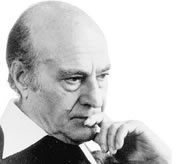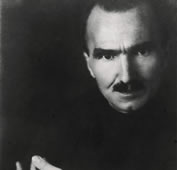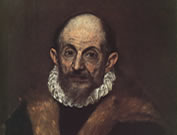




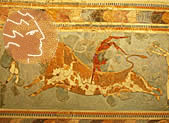

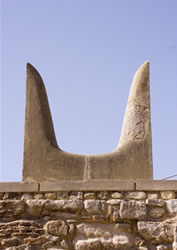
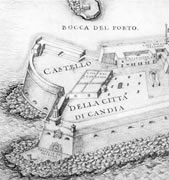
Heraklion & Crete through centuries
Neolithic Period (6500-2800 BC)
From sources of mythology together with excavations still under way today, all tell us a lot to about the history of Crete. The oldest evidence of the first inhabitants is located at Knossos where in 1900 the English archaeologist Evans discovered a whole Neolithic settlement right under the courtyard of the Minoan palaces.
Evans also discovered very old pre-ceramic settlements dated from the end of the 7th millenium. More findings indicate that Knossos has the oldest Neolithic history.
The first inhabitants of the island are believed to have come from mainland Greece. During that age, man lives in stone shacks, food derives from hunting, fishing and some form of farming. The first form of art appears during Neolithic period: from animal bones man makes tools and decorative items. He also uses and processes clay but does not yet use the ceramic wheel.
Pre-palatial period- Copper age (2800-1900 BC)
The expiry of Neolithic period, 3000 BC ushers in the Copper age. Cultural development evolves in the creation of cities, not only on the coast but in outlying mountainous regions. During this age we see the processing of valuable stones and ivory. Besides possessing a strong navy Minoan Crete has commercial ties with Cyprus, Egypt and the middle east. This is evidenced at Zakros where Cypriot copper talents (ancient coins) and Syrian ivory were found.
Old-palatial period (1900-1700 BC)
During this period the Minoan palaces are built. Cultural development is seen in all fields of human endeavour. The equality of women is noteworthy here in that women took part in public activities. From the findings in Knossos we can observe the development of painting, sculpture, ceramics and metallurgy. The four centers of Minoan Crete are: Knossos, Faistos, Mallia and Zakros. Other cities are also to be found mainly in the center and eastern parts of the island. The ancient greek city-states (separate and independent states) phenomenon does not apply here as the island is united under king Minos only.
New-Palatial Period (1700-1400 BC)
After the earthquake in 1700 BC the palaces are being rebuilt and at the same time other palaces are being added as in Arhanes, Chania and Kydonia. Cultural development is constant and due to the plethora of the findings of that era we get acquainted with the life then. Remnants of this era can be seen at most archaeological sites today.
There is a striking development in the arts, specifically in pottery, painting, stone work and goldsmithery.
Post-Palatial Period (1400-1100 BC)
The illustrious culture, however, suddenly vanishes without reason. Three of the main interpretations for this are: a) foreign invaders b) the revolt of the Cretans against the Achaens and the most plausible explanation c) the explosion of the volcano on the island of Thera (Santorini).
The Minoan civilization continues as part of Mycean civilization. The Achaens take advantage of this catastrophy, strengthening their position of the island. Excavations show the influence of these two civilizations, meanwhile commerce continues to flourish.
Iron Age-Dorians (1100-67 BC)
In the 10th century BC, the island is colonized by Dorians bringing their culture with them. The inhabitants sought refuge in the mountains and remote areas. The Dorians established themselves in the major cities like Knossos, Faistos, Gortynia, Tylisos, Hersonissos, Kydonia and Sitia. Art takes a new form with the use of iron. Culture evolves with more Dorian and eastern influences. The island continues as a commercial center.
Roman Period (67 BC - 330 AD)
Crete did not escape the clutches of the Roman empire and due to its geographical position, was intensely coveted early.
Many structures, odeons, temples, stadiums and baths are built at that time in various cities with Gortynia as the capital. At the same time Christianity arrived in Crete through the merchants who used to come from Jerusalem having listened to St. Peter’s sermons. Apostle Paul taught Christianity on the island with his pupil Titus who continued his work later.
Byzantine period (330-1204)
From the middle of the 4th century AD up to the beginning of the 13th century AD Crete is a province (“thema”) of the Byzantine empire. With the accession of Crete into Eastern Byzantium and until the Arab conquest no events of any significance occurred apart from some skirmishing.
During this period Christianity played an important role in the lives of the inhabitants of the island and was a great help in their future ordeals.
Arab rule (824-961)
During the 9th century the Arabs conquered the island and used it as a springboard for their pirate activities in the Aegean islands. They fortified the city and dug a huge moat: that’s how the city got its former name “Chandakas”. Notwithstanding the dominance of the conqueror the Cretans stuck to their traditions. We can deduce from the scant use of Arab words used today that the local culture was not influenced much by the Arab world. From the looting forays they carried out the Arabs amassed a considerable amount of goods and slaves. For this reason El.Venizelou square was established as an international slave trading center.
There were many attempts by the Byzantines to free Crete but to no avail. In 961 Nikiforos Fokas, with a big army besieged the city for nine months which was cruel and hard for the people. The Byzantines finally dug a tunnel under the walls and blew them up resulting in the collapse of two big towers including the middle tower. The treasures found were shipped to Byzantium and a few have also been found in Agion Oros (Athos).
Venetian rule (1204-1669)
From the 10th century Byzantium started to decline, bottoming in the 12th century. Crete being a province of the Byzantine empire was offered by Alexios as a gift to Bonifacio of Monferat. Because the acquisition of Crete was shaky Bonifacio traded it to the Venetians in exchange for considerable preferential benefits.
From 1212-1669 Crete was under the Venetian yoke excepting for the area of Sfakia which was never subjugated entirely. Venetian noblemen were promised enormous stretches of land.
The island was divided into six sections: Agion Apostolon, Agiou Markou, Stavrou (the cross), Kasteli, Agiou Pavlou and the Dorsoduro. Because “Chandakas” (Iraklion) was continually expanding new walls were built which can be seen today. They were state of the art and lasted 21 years of siege by the Turks later.
Despite the enslavement of Crete the arts and letters did not stop flourishing until at least the Turkish conquest and as a matter of fact were encouraged by Byzantine and Venetian influences.
Many were the Byzantine men of letters who sought refuge in Crete. Cretans were allowed to travel to Italy for further study and on their return to the island they would transfer new scientific trends or in other cases, they would excel and stay in the West. Many writers bloomed a typical example being Vincenzo Cornaro with his work “Erotokritos”.
Painting also peaked, significantly influenced by the Byzantine icongraphers. Domenikos Theotokopoulos or El Greco was born and schooled during this time.
Many masterful edifices were also built which have remained intact until today.
Turkish rule (1669 - 1913)
During the last years of Venetian rule Crete lived under the threat of Turkish invasion. In 1538 the Turks under the leadership of Admiral Barbarosa conquered a big chunk of central and western Crete. His attack was stopped in front of the great walls of Heraklion (then called Chandaka). In 1645 a Turkish army of 60.000 men via 400 ships reached and disembarked west of Chania. The city surrendered quickly and on 1645 Rethymno and other areas were also forced to surrender. By the end of 1648 the whole of Crete was in Turkish hands except for Heraklion. The siege of the city was the most dramatic episode in the strife-ridden history of the island, lasting 21 years (1648-1669) and on 27/9/1669 was forced to make a treaty.
The siege cost the lives of 117.000 Turks and nearly 30.000 Venetians and Greeks. Francesco Morozini the Administrator of Crete surrendered the city only after securing safe passage for the remainder of his army. The Turks rebuilt the city walls and converted the Christian churches to mosques.Numerous Christians abandoned Crete for fear of their lives and sought refuge in the Ionian islands. The darkest years in the long history of the island were between 1770-1821. In 1821 upon the declaration of Greek independence the Turks were enraged and were more on the offensive, lashing out at the Cretan people. Muhammed Ali the viceroy of Egypt undertook the general command of the Turkish army which by 1840 manages to take possession of the greater part of the island. The latter years of Turkish rule were shaken by multiple uprisings.
The great Cretan revolution against the Turks starts from 1866 and ends on 1868. It manifests the highest form of freedom of expression encompassing the passion of the Cretans for the unity with Greece. That revolution ends with incalculable catastrophy in material and human terms.Nevertheless the problem begins to attract the attention of the big powers who coerced Turkey to relent. During the years 1895-1896 new conflicts broke out as the period 1890-1895 regenerated old passions and hatreds and violence was an ordinary daily event. Eventually in 1897 the Greek army (from the Greek mainland) plus volunteers reach Crete and start to free the island bit by bit with the purpose of unifying Crete with Greece.
Unification with Greece
The battles ceased by 1898 after being marked by the great slaughter of Heraklion by the Turks. That’s when the great powers: France, England and Russia intervened and recognized Crete as an independent state with Prince George as Governor.
The struggles in Crete continue leading to its climax- the revolt of Therision in 1905. That revolt culminated in the unification of Crete with Greece in 1913.
History is again written in Crete during the second world war when it becomes the centre of heroic battles. In may 1941 in the greatest attack on western Crete thousands of German parachutists landed on Cretan soil. Australian, New Zealand and Greek soldiers including unarmed cretans put up a strong resistance but the numerical and technical superiority of the invader was overpowering. However the resistance movement continued against the German occupation.
Neolithic Period (6500-2800 BC)
From sources of mythology together with excavations still under way today, all tell us a lot to about the history of Crete. The oldest evidence of the first inhabitants is located at Knossos where in 1900 the English archaeologist Evans discovered a whole Neolithic settlement right under the courtyard of the Minoan palaces.
Evans also discovered very old pre-ceramic settlements dated from the end of the 7th millenium. More findings indicate that Knossos has the oldest Neolithic history.
The first inhabitants of the island are believed to have come from mainland Greece. During that age, man lives in stone shacks, food derives from hunting, fishing and some form of farming. The first form of art appears during Neolithic period: from animal bones man makes tools and decorative items. He also uses and processes clay but does not yet use the ceramic wheel.
Pre-palatial period- Copper age (2800-1900 BC)
The expiry of Neolithic period, 3000 BC ushers in the Copper age. Cultural development evolves in the creation of cities, not only on the coast but in outlying mountainous regions. During this age we see the processing of valuable stones and ivory. Besides possessing a strong navy Minoan Crete has commercial ties with Cyprus, Egypt and the middle east. This is evidenced at Zakros where Cypriot copper talents (ancient coins) and Syrian ivory were found.
Old-palatial period (1900-1700 BC)
During this period the Minoan palaces are built. Cultural development is seen in all fields of human endeavour. The equality of women is noteworthy here in that women took part in public activities. From the findings in Knossos we can observe the development of painting, sculpture, ceramics and metallurgy. The four centers of Minoan Crete are: Knossos, Faistos, Mallia and Zakros. Other cities are also to be found mainly in the center and eastern parts of the island. The ancient greek city-states (separate and independent states) phenomenon does not apply here as the island is united under king Minos only.
New-Palatial Period (1700-1400 BC)
After the earthquake in 1700 BC the palaces are being rebuilt and at the same time other palaces are being added as in Arhanes, Chania and Kydonia. Cultural development is constant and due to the plethora of the findings of that era we get acquainted with the life then. Remnants of this era can be seen at most archaeological sites today.
There is a striking development in the arts, specifically in pottery, painting, stone work and goldsmithery.
Post-Palatial Period (1400-1100 BC)
The illustrious culture, however, suddenly vanishes without reason. Three of the main interpretations for this are: a) foreign invaders b) the revolt of the Cretans against the Achaens and the most plausible explanation c) the explosion of the volcano on the island of Thera (Santorini).
The Minoan civilization continues as part of Mycean civilization. The Achaens take advantage of this catastrophy, strengthening their position of the island. Excavations show the influence of these two civilizations, meanwhile commerce continues to flourish.
Iron Age-Dorians (1100-67 BC)
In the 10th century BC, the island is colonized by Dorians bringing their culture with them. The inhabitants sought refuge in the mountains and remote areas. The Dorians established themselves in the major cities like Knossos, Faistos, Gortynia, Tylisos, Hersonissos, Kydonia and Sitia. Art takes a new form with the use of iron. Culture evolves with more Dorian and eastern influences. The island continues as a commercial center.
Roman Period (67 BC - 330 AD)
Crete did not escape the clutches of the Roman empire and due to its geographical position, was intensely coveted early.
Many structures, odeons, temples, stadiums and baths are built at that time in various cities with Gortynia as the capital. At the same time Christianity arrived in Crete through the merchants who used to come from Jerusalem having listened to St. Peter’s sermons. Apostle Paul taught Christianity on the island with his pupil Titus who continued his work later.
Byzantine period (330-1204)
From the middle of the 4th century AD up to the beginning of the 13th century AD Crete is a province (“thema”) of the Byzantine empire. With the accession of Crete into Eastern Byzantium and until the Arab conquest no events of any significance occurred apart from some skirmishing.
During this period Christianity played an important role in the lives of the inhabitants of the island and was a great help in their future ordeals.
Arab rule (824-961)
During the 9th century the Arabs conquered the island and used it as a springboard for their pirate activities in the Aegean islands. They fortified the city and dug a huge moat: that’s how the city got its former name “Chandakas”. Notwithstanding the dominance of the conqueror the Cretans stuck to their traditions. We can deduce from the scant use of Arab words used today that the local culture was not influenced much by the Arab world. From the looting forays they carried out the Arabs amassed a considerable amount of goods and slaves. For this reason El.Venizelou square was established as an international slave trading center.
There were many attempts by the Byzantines to free Crete but to no avail. In 961 Nikiforos Fokas, with a big army besieged the city for nine months which was cruel and hard for the people. The Byzantines finally dug a tunnel under the walls and blew them up resulting in the collapse of two big towers including the middle tower. The treasures found were shipped to Byzantium and a few have also been found in Agion Oros (Athos).
Venetian rule (1204-1669)
From the 10th century Byzantium started to decline, bottoming in the 12th century. Crete being a province of the Byzantine empire was offered by Alexios as a gift to Bonifacio of Monferat. Because the acquisition of Crete was shaky Bonifacio traded it to the Venetians in exchange for considerable preferential benefits.
From 1212-1669 Crete was under the Venetian yoke excepting for the area of Sfakia which was never subjugated entirely. Venetian noblemen were promised enormous stretches of land.
The island was divided into six sections: Agion Apostolon, Agiou Markou, Stavrou (the cross), Kasteli, Agiou Pavlou and the Dorsoduro. Because “Chandakas” (Iraklion) was continually expanding new walls were built which can be seen today. They were state of the art and lasted 21 years of siege by the Turks later.
Despite the enslavement of Crete the arts and letters did not stop flourishing until at least the Turkish conquest and as a matter of fact were encouraged by Byzantine and Venetian influences.
Many were the Byzantine men of letters who sought refuge in Crete. Cretans were allowed to travel to Italy for further study and on their return to the island they would transfer new scientific trends or in other cases, they would excel and stay in the West. Many writers bloomed a typical example being Vincenzo Cornaro with his work “Erotokritos”.
Painting also peaked, significantly influenced by the Byzantine icongraphers. Domenikos Theotokopoulos or El Greco was born and schooled during this time.
Many masterful edifices were also built which have remained intact until today.
Turkish rule (1669 - 1913)
During the last years of Venetian rule Crete lived under the threat of Turkish invasion. In 1538 the Turks under the leadership of Admiral Barbarosa conquered a big chunk of central and western Crete. His attack was stopped in front of the great walls of Heraklion (then called Chandaka). In 1645 a Turkish army of 60.000 men via 400 ships reached and disembarked west of Chania. The city surrendered quickly and on 1645 Rethymno and other areas were also forced to surrender. By the end of 1648 the whole of Crete was in Turkish hands except for Heraklion. The siege of the city was the most dramatic episode in the strife-ridden history of the island, lasting 21 years (1648-1669) and on 27/9/1669 was forced to make a treaty.
The siege cost the lives of 117.000 Turks and nearly 30.000 Venetians and Greeks. Francesco Morozini the Administrator of Crete surrendered the city only after securing safe passage for the remainder of his army. The Turks rebuilt the city walls and converted the Christian churches to mosques.Numerous Christians abandoned Crete for fear of their lives and sought refuge in the Ionian islands. The darkest years in the long history of the island were between 1770-1821. In 1821 upon the declaration of Greek independence the Turks were enraged and were more on the offensive, lashing out at the Cretan people. Muhammed Ali the viceroy of Egypt undertook the general command of the Turkish army which by 1840 manages to take possession of the greater part of the island. The latter years of Turkish rule were shaken by multiple uprisings.
The great Cretan revolution against the Turks starts from 1866 and ends on 1868. It manifests the highest form of freedom of expression encompassing the passion of the Cretans for the unity with Greece. That revolution ends with incalculable catastrophy in material and human terms.Nevertheless the problem begins to attract the attention of the big powers who coerced Turkey to relent. During the years 1895-1896 new conflicts broke out as the period 1890-1895 regenerated old passions and hatreds and violence was an ordinary daily event. Eventually in 1897 the Greek army (from the Greek mainland) plus volunteers reach Crete and start to free the island bit by bit with the purpose of unifying Crete with Greece.
Unification with Greece
The battles ceased by 1898 after being marked by the great slaughter of Heraklion by the Turks. That’s when the great powers: France, England and Russia intervened and recognized Crete as an independent state with Prince George as Governor.
The struggles in Crete continue leading to its climax- the revolt of Therision in 1905. That revolt culminated in the unification of Crete with Greece in 1913.
History is again written in Crete during the second world war when it becomes the centre of heroic battles. In may 1941 in the greatest attack on western Crete thousands of German parachutists landed on Cretan soil. Australian, New Zealand and Greek soldiers including unarmed cretans put up a strong resistance but the numerical and technical superiority of the invader was overpowering. However the resistance movement continued against the German occupation.
